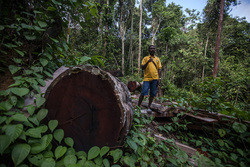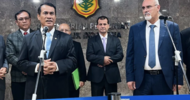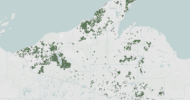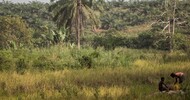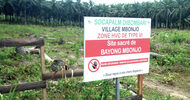Why I stand for my tribe’s forest: It gives us food, culture, and life (commentary)
Commentary by Arkilaus Kladit
- For the occasion of International Indigenous Peoples Day August 9, 2020, Arkilaus Kladit, a member of the Knasaimos-Tehit people in South Sorong Regency in West Papua Province, Indonesia, writes about the importance of his tribe’s customary forests.
- Arkilaus, who is a member of the Knasaimos Indigenous Peoples Council, describes his tribe’s long struggle to secure recognition of his tribe’s customary lands by the Indonesian government.
- Arkilaus explains how the Knasaimos-Tehit people are dependent on forests for food, community resilience, and cultural significance.
- This post is a commentary. The views expressed are those of the author, not necessarily Mongabay.
My name is Arkilaus Kladit. I’m from the Knasaimos-Tehit tribe in South Sorong Regency, West Papua Province, Indonesia. For decades my tribe has been fighting to protect our forests from outsiders who want to log it or clear it for palm oil. For my people, the forest is our mother and our best friend. Everything we need to survive comes from the forest: food, medicines, building materials, and there are many sacred sites in the forest.
We have been taught for generations about how to maintain a good relationship with the forest. If it is cut down, it will be the same as cutting down our lives. This has been critical for us during this Covid pandemic because, with the shortage of rice, we have been relying on our traditional staple food, sago, that comes from the forest. And we have gone further by harvesting it to provide food for the surrounding area.
The first threat to our forest was in 1988-89 when I was young. The government wanted to make a transmigration scheme settlement in our area but our elders rejected it because we were worried a lot of new people would harm the forest. Then in the early 2000s companies came wanting to log the valuable trees in our forest. After some years of struggle, we saw them off in 2005 but only after they did some damage to our forest.
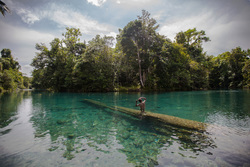
The most recent threat is from oil palm. We heard news reports in 2012 there was an oil palm company going into a neighboring village. The news was quite alarming. Our tribe was sad. We had heard about thousands of hectares being cleared for oil palm plantations in Merauke and Sorong Districts. We thought that if oil palm is planted in a neighboring village, it is certain that the forests around our villages, Sira and Manggroholo, could also be under threat. But we stood firm on protecting our forest for our children and grandchildren. Our people consistently oppose oil palm, because we realize that our economic, customary and cultural lives depend heavily on the forest.
After our earlier fight with the illegal loggers, we decided in 2006 that we wanted to gain recognition for our customary forests. What has interested me most was getting the rights of the people to manage their forest. We worked with our Non-Government Organisation friends, including Bentara and Greenpeace, to do participatory mapping of our own village lands and mark the boundary of all 81,446 hectares of our tribal lands. It is our custom to pass down from generation to generation where the boundaries of our forests are. Everything is collective, or is inherited collectively through the clans; it comes from our ancestors.
In 2008 we made a declaration to reject logging and palm oil. We invited the Regent and local Parliament to tell them that our area is small, if these forests are cut down, where do we go then? Where will we find wood to build our house? Where will we go to make our gardens? Where do we go to get medicines? If forests in these two villages are cut down, where will we move to?
So then we began the process of getting the recognition for our customary forests so that it will not be continually disturbed by logging licenses or permits for oil palm plantations. In 2014, after a long struggle, we had success with Village Forest permits for 3,545 hectares of customary forests of the two villages Mangroholo and Sira. We celebrated securing permits from the Ministry of Environment and Forestry as part of the government’s social forestry program. We now have the legal rights to face the threat of illegal deforestation, oil palm planting that damages the environment.
A good example of how different it is now with the Village Forest permit. One day when we were patrolling in our forest we found merbau or ironwood trees (Intsia bijuga) had been illegally cut. Merbau is one of the main trees targeted by the illegal loggers. We caught the people doing this and issued them with a customary fine of Rp40 million ($2,700).
As well, since we obtained the status of Village Forest and we manage the forest ourselves, we are more organized in using Non Timber Forest Products (NTFP) such as damar (tree resin), agarwood, and sago, from a big palm that grows in our swamp forests. But our people have always made use of forests sustainably by taking forest products as needed. Especially with sago we have done a lot of work to turn it into a small enterprise that makes a good income for the village so we can pay things like school fees. We have had training, received new processing machines to speed up production, and help with local marketing to sell what we make. We have been providing food for the local region during Covid as the local government was buying our sago and giving it to the people. We are proud to make some money from our protected forest using our customary management without harming it. The forest is still here tall and strong.
But we still have a long way to go. We are now fighting for the recognition of the whole Knasaimos tribal area of 81,446 hectares as Customary Forest. We were very happy in 2018 when the Governor of West Papua Dominggus Mandacan made his commitment to make 70% of West Papua Province protected areas. For us it means the Governor is fighting alongside us.
For the future we hope that the regent of our District, Mr Samsudin will soon issue a regional regulation that recognizes Knasaimos rights and forest, and that the Ministry of Environment and Forestry will support our application for a Customary Forest permit through the government Social Forestry Scheme so we can be on the frontline in supporting the government to protect Papua’s forests.
I hope that every village in the Knasaimos customary area can experience the customary forest program to protect the future of our mother, the forest, and the rights to life of communities in Papua. Getting rights to forests in one’s own area is the key to protecting the forest and community-based forest management. That is our aspiration, and this will make me very happy.


